New Malden Trunk Mains (2018)
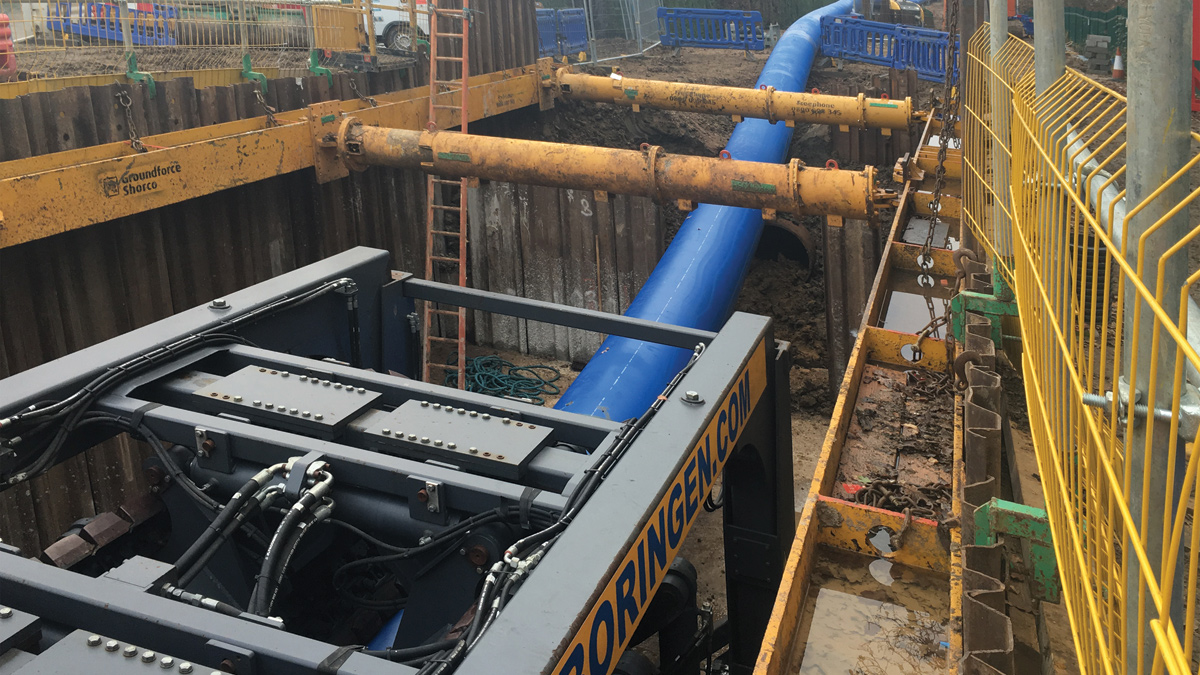
Sliplining - Courtesy of SMB
New Malden pipe-track contains 3 (No.) 30” and 1 (No.) 48” trunk mains, with the oldest main being nearly 170 years old. The mains feed the Surbiton supply zone and serve as bulk transfer mains to supply south-west London. Kingston Council is going to build a new cycleway over the track; however, these mains are in poor condition and have a history of failures. eight2O was engaged by Thames Water Utilities Ltd (TWUL) to carry out a pipe condition assessment to identify pipeline sections at a risk of failure and requiring rehabilitation. Subsequently, eight2O delivered a £17m project to rehabilitate these trunk mains.
Background
As part of its ‘Go Cycle’ programme, Kingston Council will be constructing a new cycleway over the pipe-track between Coombe Road and Raynes Park Recreation Ground in summer 2018. Following Kingston Council’s initial enquiry regarding the proposed cycleway in December 2013, Thames Water undertook non-destructive testing (NDT) and inspection of the existing mains along the pipe-track. One of the 30” mains burst along the pipe-track in June 2015, causing flooding in the local area and interruption to the local water supply. The results of the NDT investigations and inspections also raised concerns about the condition of the mains.
In December 2015, eight2O/SMB was engaged by Thames Water to undertake a pipeline condition assessment to identify which pipe sections were at a risk of failure, requiring rehabilitation, and to carry out the necessary pipeline rehabilitation works. eight2O is an alliance formed to deliver capital investment works for TWUL through AMP6, and SMB is a design and build joint venture made up of Skanska, Stantec UK and Balfour Beatty.
Project site and existing assets
The 3 (No.) 30” and 1 (No.) 48” trunk mains, along with 1 (No.) disused 30” main, are laid side by side within an approximately 8m wide narrow pipe-track in New Malden.
The western section of the pipe-track is currently used by the public as a cycleway and footpath; however, most of the pipe-track (1.2km in length) is an unpaved track with no public access.
This section of pipe-track runs through both a cutting and along the top of an embankment, lined with areas of dense scrub and woodland. A railway line runs parallel on the south side of the pipe-track.
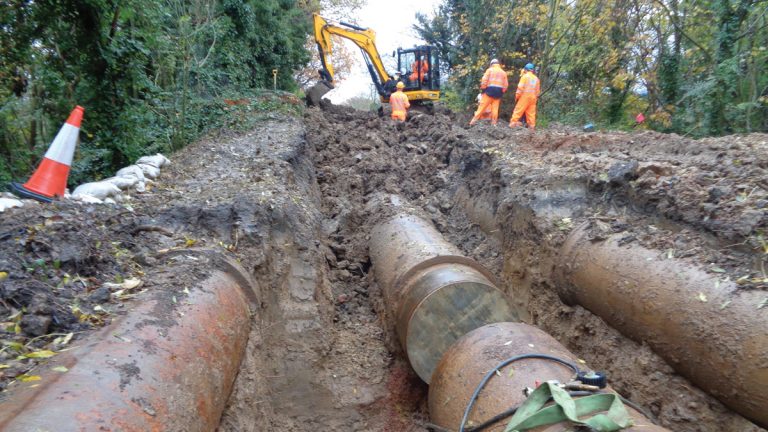
Existing trunk mains in pipe-track – Courtesy of SMB
The existing trunk mains are cast iron water mains, each laid in different time periods between 1850 and 1925. The mains are laid at a shallow depth at many locations along the track, sometimes with as little as 300mm cover.
The poor condition of the mains means the increased overburden during the cycleway construction and maintenance phases would significantly increase the risk of pipe failures and consequent supply interruptions. This could result in the need to close the new cycleway to undertake repairs in the future if no rehabilitation work is carried out on these mains in advance of the cycleway’s construction.
Site investigations
During the project’s design stage, the following site investigations were carried out:
- NDT inspections to obtain pipe wall thickness of the existing trunk mains.
- Stray current surveys to check for the presence of stray currents from the adjacent electrified railway, which could accelerate corrosion and deterioration of the existing mains.
- Sahara surveys to trace the alignment of the water mains and identify and locate leaks.
- SmartBall Pipe Wall Assessment (PWA) surveys to identify stress in the pipe wall of the trunk mains and locate leaks.
- Trial holes to assess constructability of the proposed works.
- Soil testing to identify the aggressiveness of the soil environment.
SmartBall is a free-swimming tool to locate leaks using acoustic technology. The PWA technology screens metallic pipes for magnetic anomalies associated with an increase in wall stress caused by either pipe wall thinning, corrosion pitting, cracks, or bending due to external loading. Stress within the pipe wall could be indicative of degradation of the pipe, and this survey was used to support the design outputs and help determine whether there was a need to rehabilitate the existing trunk mains.
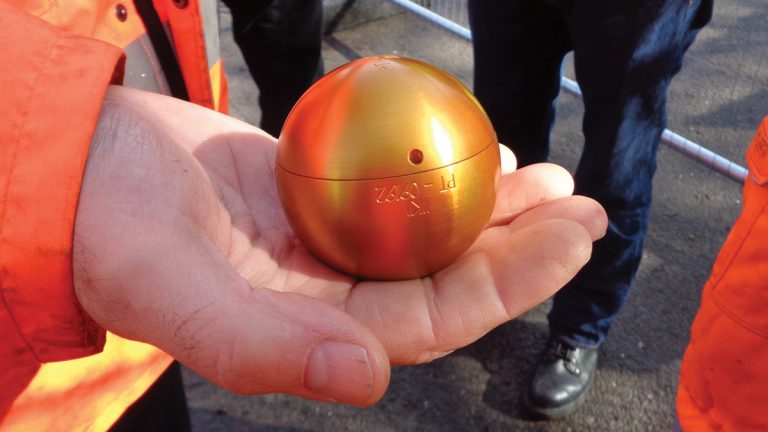
SmartBall – Courtesy of SMB
The pipe condition risk model developed for this project considers PWA results as well as other factors, including ground corrositivity, history of previous leaks/bursts, pipe wall thickness measurements, levels of corrosion found on the pipe and the condition of the pipe’s coating.
The results of the stray current surveys revealed that stray currents were not present along the pipe-track so could not be the cause of corrosion to the pipes. The corrosion is thought to have been caused by the aggressive ground conditions found at the site.
Pipeline condition assessment
Following completion of the site investigations, pipe condition risk analysis was carried out by combing a range of information sources. The results identified pipeline sections with a risk of failure requiring rehabilitation.
For this assessment, the following six primary data groups were used to determine each water main’s likely condition:
- Structural: Structural strength of the pipelines when subjected to internal and external loading.
- Water Loss: Leakage and burst history.
- Environment: Factors such as soil corrositivity and conductivity information.
- Susceptibility: The condition of the pipe’s coating protection system, and its resistance to corrosion.
- Aggregated corrosion: The extent of corrosion found on one or more of the neighbouring parallel pipeline.
- PWA: Assessment of stress levels within the pipe wall.
Pipe condition probability scores were assigned to each of the data groups outlined above, depending on whether the condition could be described as good, fair, bad or uncertain due to insufficient information. The pipe condition probability scores for the six categories were weighted to control their degree of influence.
The weightings were based on how influential each data group is at describing the condition of the pipe.
A mathematical probability model was used to combine the scores from the various data groups to generate an overall pipe condition score along the entire length of each pipeline.
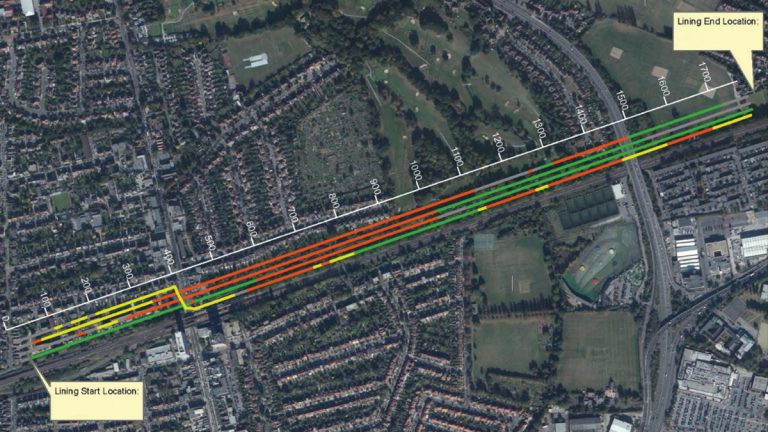
Fig 1: Graphical image of pipe condition assessment results – Courtesy SMB
The results of the pipe condition assessment are shown in diagrammatic form in Figure 1 (previous page), which summarises the outputs by using a colour coded scale along the length of the pipelines. The colours depict the condition rating along the pipelines categorised by:
- Red: At risk of failure.
- Yellow: Some cause for concern.
- Green: Satisfactory.
The scope of the pipeline rehabilitation was defined by using the results of this assessment.
Design
As a part of the engineering investigation, hydraulic modelling work was carried out to confirm that the proposed relining works would not have a detrimental effect on the existing supply network’s zonal pressures and transfer capacity of the bulk transfer system.
The modelling results also indicated that from a hydraulic point of view, one of the 30” mains could be decommissioned along the New Malden pipe-track section. This saved significant project costs and time over unnecessary rehabilitation works.
These trunk mains are strategically important to the water supply for south-west London. Various scenarios were modelled to investigate the feasibility of isolating the relining sections of each main during the works. Contingency supply measures, such as cross connection pipework, were identified to maintain supply during pipe and system failures.
The pipeline rehabilitation method was sliplining a fully structural PE liner into the host mains. The selected PE liner was a 710mm OD PE100 SDR11 pipe for the existing 30” CI mains and a 1000mm OD PE100 SDR13.6 pipes for the 48” CI main.
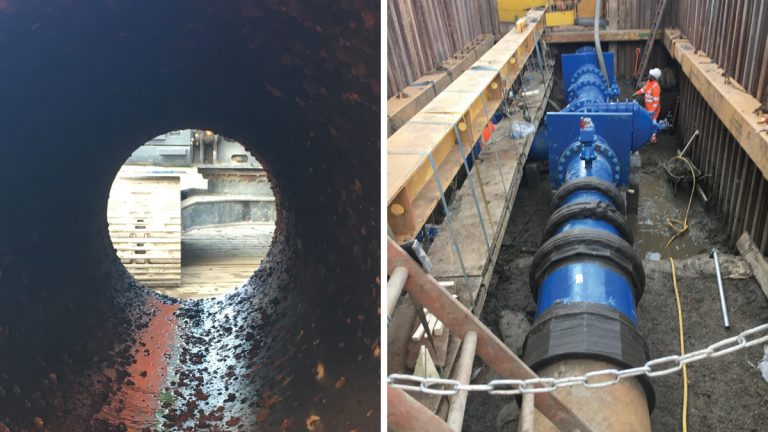
(left) 30″ cast iron main and (right) new cross section – Courtesy of SMB
The results of the pipe’s structural assessment identified that the existing 30” and 48” CI host pipes are not structurally sound, so thick-walled PE liners were selected to protect the relined mains from vehicle loading during the construction and maintenance phases of the proposed cycleway.
The existing mains along the pipe-track are buried at very shallow pipe cover depths in some sections. It was proposed to raise the existing ground surface levels to achieve a minimum of 600mm pipe cover depth at these locations.
The additional 300mm pavement thickness will ensure a minimum of 900mm pipe cover depth is maintained when the new cycleway is built over the pipe-track. This will ensure the existing mains (including the pipeline sections which are not to be rehabilitated this time) are protected from future vehicle loading on the proposed cycleway.
The outline for proposed pipeline rehabilitation works along the pipe-track included:
- Sliplining the existing 30” No.1 main with 710mmOD PE SDR 11 pipes along with line valves, cross connections and other pipeline ancillaries (1700m in length).
- Sliplining the existing 30” No.4 main with 710mmOD PE SDR 11 pipes (approx. 450m in length).
- Sliplining the 48” main with 1000mmOD PE SDR13.6 pipe (1150m in length), along with a line valve and other pipeline ancillaries.
- Replacement of the existing 30” No.4 main with DN800 DI pipes (30m in length), along with a line valve and other pipeline ancillaries.
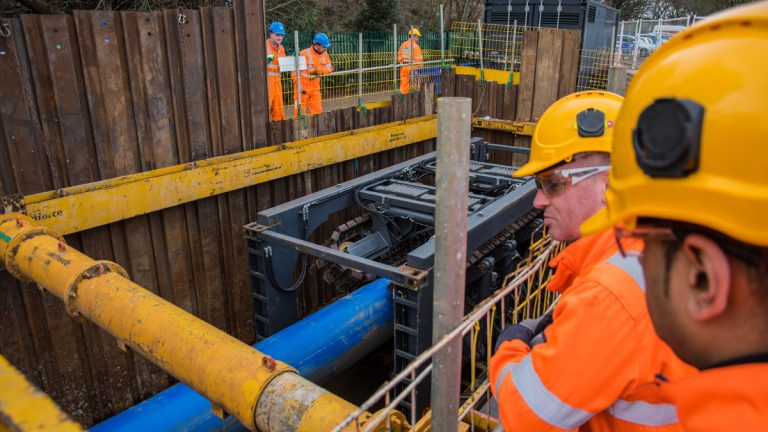
Pipeline sliplining using pipe pusher – Courtesy of SMB
Sections of one of the 30” mains will not be rehabilitated this time due to this pipe being assessed to be in a satisfactory condition. These sections of the main are to be monitored and protected by the installation of a Syrinix leak and burst detection system.
Construction
Construction work started in August 2016. The rehabilitation of the 3 (No.) water mains had to be carried out one main at a time to maintain water supplies. Prior to commencement of the pipeline rehabilitation works, 2 (No.) cross connections were made between one of the trunk mains and the local distribution mains to provide contingency for supply.
For the sliplining works, a pipe pusher, capable of pushing 130 tonnes, was used to slipline 2 (No.) mains (both 30” and 48” mains). 1200m of 710mm OD PE liner and 1140m of 1000mm OD PE liner were installed with a single pipe push operation.
This long-distance pipe pushing operation eliminated the need for building lining pits along the pipe-track, which in turn mitigated the risks of working over the existing fragile trunk mains.
Railway tracks run closely parallel to the south side of the pipe-track. Hence, the works were carried out by liaising closely with Network Rail.
New Malden Trunk Mains Project – Key Participants
- Main Contractors: SMBjv – Skanska, Stantec and Balfour Beatty
- Designer: Stantec UK
- Sub-contractor: Instalcom
The pipe-track between Coombe Road and Raynes Park is an environmental sensitive area and is a locally designated Site of Importance for Nature Conservation (SINC).
The site is a habitat suitable for a range of protected species including bats, reptiles, badgers, invertebrates and nesting birds. The works were carried out so as to ensure the local ecology was not disturbed by construction activities.
The construction of the pipeline rehabilitation which removes the risk of pipeline failure was successfully completed in April 2018, allowing the construction of the new cycleway by Kingston Council in the summer of 2018.



